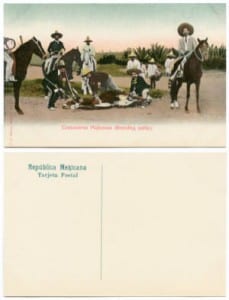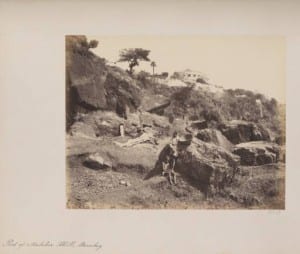 This photograph was taken by J.G. Hatton between 1905 and 1920. It depicts a group of Mexican “rancheros” that have roped and taken down a bull. In this post card you can see two distinct groups of men, one group wearing dark and what appears to be more luxurious clothing and the other group wearing simple white clothes. The men in the white appear to be of a lower class than the men in the dark clothing. In the center/back of the post card you can see farmers who have stopped their work and are beginning to walk toward the action. You can tell this photograph is staged by the fact that most everyone in the post card is looking right at the camera instead of focusing on holding down the bull. The man on the right of the photograph seems to be the leader of the group as he is the only one who is not dressed in either black or white, he is wearing a grey suit. Because of his positioning in the photo, he appears to be much bigger than everyone else and clearly wants to be the main attraction of the photograph. Have these men been instructed by the man in the grey to hold down the bull for this picture? Is the man in the grey the owner of the property?
This photograph was taken by J.G. Hatton between 1905 and 1920. It depicts a group of Mexican “rancheros” that have roped and taken down a bull. In this post card you can see two distinct groups of men, one group wearing dark and what appears to be more luxurious clothing and the other group wearing simple white clothes. The men in the white appear to be of a lower class than the men in the dark clothing. In the center/back of the post card you can see farmers who have stopped their work and are beginning to walk toward the action. You can tell this photograph is staged by the fact that most everyone in the post card is looking right at the camera instead of focusing on holding down the bull. The man on the right of the photograph seems to be the leader of the group as he is the only one who is not dressed in either black or white, he is wearing a grey suit. Because of his positioning in the photo, he appears to be much bigger than everyone else and clearly wants to be the main attraction of the photograph. Have these men been instructed by the man in the grey to hold down the bull for this picture? Is the man in the grey the owner of the property?
 In the photograph “Part of Malabar Hill, Bombay”, William Henderson and William Johnson have chosen to photograph two young Indian children who are dressed in rags and appear very skinny and almost malnourished. The girl has a basket to the right of her, indicating that she is probably already being put to work carrying food or materials from one place to another. At the very top of the photograph you can see what appears to be a large home with a wall surrounding it, giving the impression that there is someone important or affluent who lives there while right outside their walls are two hardworking and malnourished Indian children. The photo takes place in Bombay, India where the British colonizers had their base of operation meaning that the house most likely belonged to a member of the British government or army. The main theme of this photograph is the immense disparity of wealth that existed in the mid 1800’s throughout India.
In the photograph “Part of Malabar Hill, Bombay”, William Henderson and William Johnson have chosen to photograph two young Indian children who are dressed in rags and appear very skinny and almost malnourished. The girl has a basket to the right of her, indicating that she is probably already being put to work carrying food or materials from one place to another. At the very top of the photograph you can see what appears to be a large home with a wall surrounding it, giving the impression that there is someone important or affluent who lives there while right outside their walls are two hardworking and malnourished Indian children. The photo takes place in Bombay, India where the British colonizers had their base of operation meaning that the house most likely belonged to a member of the British government or army. The main theme of this photograph is the immense disparity of wealth that existed in the mid 1800’s throughout India.
